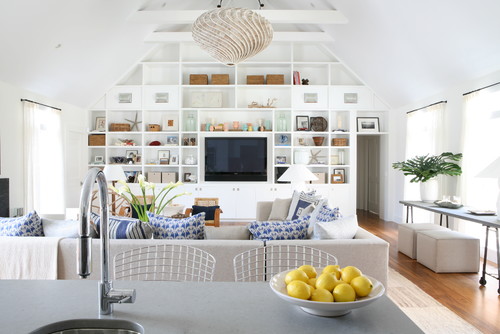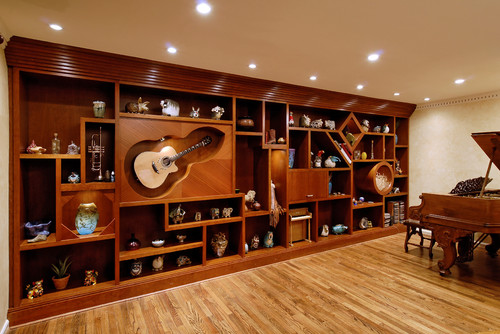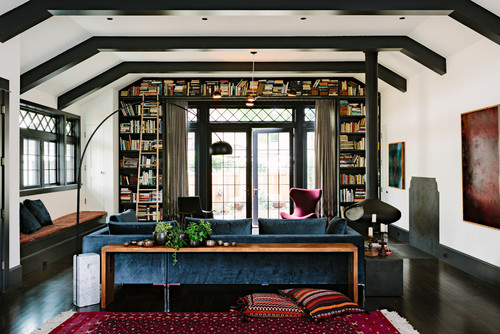
Houzz.com
Remodeling a house gives you the opportunity to make dozens (if not hundreds) of design decisions. Some of these choices—like paint colors or types of furniture—can be easily swapped out if you change your mind in a few years. Taking down a sheet of wallpaper that turned out to be way chicer on the roll than on the wall? That’s easy for a seasoned DIYer.
But other selections are more permanent and will stay with the house for years (or decades) to come. Built-ins, for example, are a type of permanent architectural feature that can also enhance your home’s appearance.
But, homeowners, before you decide to install a built-in upgrade, make sure you know what you’re getting into. Keep reading for a guide to built-ins, including costs, benefits, and the return you can expect on your investment.
What are built-ins?
Built-ins are exactly what they sound like: features that are built into the interior of a home.
“Built-ins can range from open shelves in the kitchen, bath, bedroom, or great room to a butler’s pantry for that open space between your kitchen and dining room,” says Jen Horner, a real estate agent with Re/Max Masters in Salt Lake City.
Other built-ins you’ll commonly see in a home are bookshelves in an office, shelving around fireplace (which is often used for storage or decor), and the inside of a closet or pantry.
Why are built-ins popular?
Built-ins are a great way to make use of the space in a home, particularly storage areas. A few built-ins here and there will allow you to gain useful space while adding character to your home. Whether it’s a bookshelf or a bench seat, a built-in feature will add a luxe feature that’s unique to your space.
“Built-ins can provide a touch of custom to what would otherwise be a room of walls with no character or dimension,” says Horner.
Photo by JAMES DIXON ARCHITECT PC
Built-ins are incredibly versatile and varied, and they’re a great addition to your home if you’re looking to optimize space and storage.
“Built-ins can be a no-brainer for that space in your home that you continually ask yourself what to do with it,” Horner says.
According to John Kostrey, a broker associate with Nourmand and Associates, a Los Angeles–based luxury real estate boutique, the key to successful built-ins is being creative.
“Adding innovative custom storage solutions—such as closet organizers, pull-out trash and recycling bins, and even pull-out pet food and water bowls—is a great and relatively inexpensive way to add value,” he says. “Using hidden space under the staircase—like Harry Potter’s closet [bedroom] under the stairs—is another great way to maximize space and add functional storage, pantry space, or even a mini office area.”
What are the potential downsides of installing built-ins?
Photo by Shea Studio Interiors, Inc
Like we mentioned above, built-ins are a permanent design feature, so take every step possible to visualize the end result before swinging a sledgehammer.
“Do your homework before making the decision to add built-ins to a certain room,” Horner says. “Think through how a built-in can enhance the space. Is a built-in the best use of space? Will it make the room feel smaller and cramped? Or will it take a space that isn’t being used wisely and optimize it by increasing storage or adding to the decor?”
Erin Powell, design director and principal designer at roOomy, which offers virtual staging services, recommends using virtual staging software rather than relying on your imagination.
“Virtual staging can be a great way for a homeowner to determine if built-ins will work in a particular space,” she says. “You’re able to see the room in various configurations.”
Easy steps like measuring out the built-in and taping it off with painter’s tape will help you gain a sense of how much space is being used—or saved.
According to the experts at Mr. Handyman, a home maintenance and repair company, three of the most popular types of built-ins are bookshelves, seating, and entertainment centers. Here’s a quick look at what you can expect to pay for each.
Built-in bookshelves: According to Home Advisor, built-in bookshelves installed by a professional carpenter cost an average of $2,541. If you buy the materials yourself, you can usually get a handyman to install them for $30 to $130 per hour.
Built-in seating: According to Fixr, the average cost of installing built-in seating is $840 to $1,680. The final cost will depend on factors including materials, size of the seat, and the layout and structure of the room.
For example, Fixr notes that installing a small window seat in a living room usually takes one to two days using an inexpensive wood like pine, and estimates labor costs from $560 to $1,120.
Built-in entertainment center: This project can be costly, with an estimated cost of $8,000 to $9,500, according to Fixr. The planning process, overseen by a professional contractor or carpenter, will take about a week of work (including preliminary measurements, meetings, and designs) and can cost anywhere from $1,400 to $2,450. If you use a quality wood, like oak, materials will likely run about $1,000 to $1,500. Finally, labor will take three to five days. Since the average hourly fee for carpenters is about $70, that puts the total cost of labor at around $1,680 to $2,800.
Return on investment of a built-in
If resale value is important to you, then you’ll be excited to hear that, for the most part, built-ins can increase the value of a home as long as they provide more function to the space. A place to display all those extra cookbooks or a bench seat that provides more seating for family gatherings is extremely attractive to potential buyers.
“In today’s market, storage is paramount to buyers,” Kostrey says. “That makes the placement of built-ins, and the amount of storage they offer, even more important than before.”
The post The Ultimate Guide to Built-Ins—and Why Buyers Still Find Them Valuable appeared first on Real Estate News & Insights | realtor.com®.




No comments:
Post a Comment